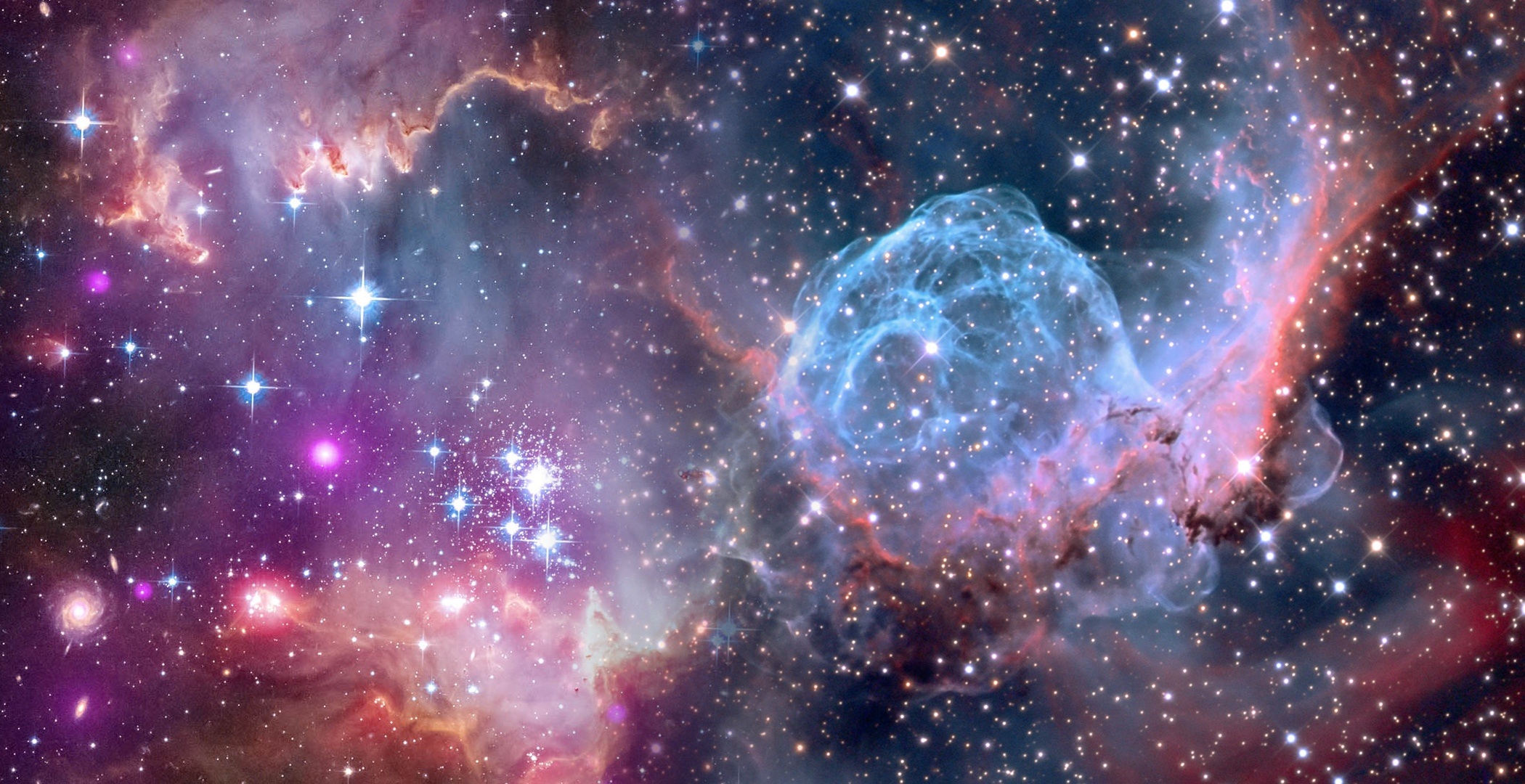
Why WCS.jl package
After the introduction of package FITSIO.jl for handling FITS files in Julia, another package was required to manage the World Coordinate System(WCS) transformations of a FITS object. The WCS info. is present in the header of one of the HDU(s) of a FITS file. These transformations map the pixel locations in an image to their real-world units, such as their position on the sky sphere. These transformations can work both forward (from pixel to sky) and backward (from sky to pixel).
This package wraps the WCSLIB C library.
Installation
WCS.jl is a registered package in Julia and can be installed from package manager as:
pkg> add WCS
or it can be build from source as:
julia> Pkg.clone("https://github.com/JuliaAstro/WCS.jl")
Usage
After installing the package, you can start using it with
julia> using WCS
Creating a WCS object
WCS objects are defined by a type WCSTransform which contains the following fields based on the information present in the header:
flag::Cint
naxis::Cint
crpix::Ptr{Cdouble}
pc::Ptr{Cdouble}
cdelt::Ptr{Cdouble}
crval::Ptr{Cdouble}
cunit::Ptr{Cvoid}
ctype::Ptr{Cvoid}
lonpole::Cdouble
latpole::Cdouble
restfrq::Cdouble
restwav::Cdouble
npv::Cint
npvmax::Cint
pv::Ptr{PVCard}
nps::Cint
npsmax::Cint
ps::Ptr{PSCard}
cd::Ptr{Cdouble}
crota::Ptr{Cdouble}
altlin::Cint
velref::Cint
alt::NTuple{4, UInt8}
colnum::Cint
colax::Ptr{Cint}
cname::Ptr{Cvoid}
crder::Ptr{Cdouble}
csyer::Ptr{Cdouble}
czphs::Ptr{Cdouble}
cperi::Ptr{Cdouble}
wcsname::NTuple{72, UInt8}
timesys::NTuple{72, UInt8}
trefpos::NTuple{72, UInt8}
trefdir::NTuple{72, UInt8}
plephem::NTuple{72, UInt8}
timeunit::NTuple{72, UInt8}
dateref::NTuple{72, UInt8}
mjdref::NTuple{2, Cdouble}
timeoffs::Cdouble
dateobs::NTuple{72, UInt8}
datebeg::NTuple{72, UInt8}
dateavg::NTuple{72, UInt8}
dateend::NTuple{72, UInt8}
mjdobs::Cdouble
mjdbeg::Cdouble
mjdavg::Cdouble
mjdend::Cdouble
jepoch::Cdouble
bepoch::Cdouble
tstart::Cdouble
tstop::Cdouble
xposure::Cdouble
telapse::Cdouble
timsyer::Cdouble
timrder::Cdouble
timedel::Cdouble
timepixr::Cdouble
obsgeo::NTuple{6, Cdouble}
obsorbit::NTuple{72, UInt8}
radesys::NTuple{72, UInt8}
equinox::Cdouble
specsys::NTuple{72, UInt8}
ssysobs::NTuple{72, UInt8}
velosys::Cdouble
zsource::Cdouble
ssyssrc::NTuple{72, UInt8}
velangl::Cdouble
ntab::Cint
nwtb::Cint
tab::Ptr{Cvoid} # Ptr{tabprm}
wtb::Ptr{Cvoid} # Ptr{wtbarr}
lngtyp::NTuple{8, UInt8}
lattyp::NTuple{8, UInt8}
lng::Cint
lat::Cint
spec::Cint
cubeface::Cint
types::Ptr{Cint}
lin::linprm
cel::celprm
spc::spcprm
err::Ptr{WCSErr}
m_flag::Cint
m_naxis::Cint
m_crpix::Ptr{Cdouble}
m_pc::Ptr{Cdouble}
m_cdelt::Ptr{Cdouble}
m_crval::Ptr{Cdouble}
m_cunit::Ptr{Cvoid}
m_ctype::Ptr{Cvoid}
m_pv::Ptr{PVCard}
m_ps::Ptr{PSCard}
m_cd::Ptr{Cdouble}
m_crota::Ptr{Cdouble}
m_colax::Ptr{Cint}
m_cname::Ptr{Cvoid}
m_crder::Ptr{Cdouble}
m_csyer::Ptr{Cdouble}
m_czphs::Ptr{Cdouble}
m_cperi::Ptr{Cdouble}
m_tab::Ptr{Cvoid} # Ptr{tabprm}
m_wtb::Ptr{Cvoid} # Ptr{wtbarr}
Creating from scratch
To create a WCSTransform from scratch, we can use the constructor like:
julia> wcs = WCSTransform(2;
cdelt = [-0.066667, 0.066667],
ctype = ["RA---AIR", "DEC--AIR"],
crpix = [-234.75, 8.3393],
crval = [0., -90],
pv = [(2, 1, 45.0)])
WCSTransform(naxis=2)
where the first argument is the number of axes naxis and keyword arguments can also be passed to set various attributes of the transform. Specifying keyword arguments is equivalent to setting them after construction and the above is equivalent to:
julia> wcs = WCSTransform(2)
julia> wcs.cdelt = [-0.066667, 0.066667]
julia> wcs.ctype = ["RA---AIR", "DEC--AIR"]
julia> wcs.crpix = [1000., 1000.]
julia> wcs.crval = [0., -90]
julia> wcs.pv = [(2, 1, 45.0)]
Both will return a WCSTransform object.
Creating from a Header
Currently, we can use from_header(header) to convert the header which is in string format to a WCSTransform object.
We can also pass a keyword argument relax which determines the treatment of non-standard keywords. The default is to accept all known non-standard keywords. Use relax=WCS.HDR_NONE to ignore all non-standard keywords. Use, e.g., relax=(WCS.HDR_RADECSYS & WCS.HDR_CROTAia) to only accept selected non-standard keywords.
There exisits a scope to make a WCSTransform object from a FITSHeader object and vice-versa.
Converting a WCSTransform back to Header
We can write a WCSTransform object back to a FITS header in form of a string by using to_header(wcs). The relax keyword can be used here too for controling how non-standard extensions to the WCS standard are handled.
Transformations
1) Pixel Coordinate to World Coordinate
Pixel Coordinate: Coordinates of each pixel in your N dimensional image. World Coordinate: Coordinates that serve to locate a measurement in some multidimensional parameter space. They include, for example, a measurable quantity such as the frequency or wavelength associated with each point in a spectrum or, more abstractly, the longitude and latitude in a conventional spherical coordinate system which define a direction in space.
Consider the above wcs object, the transformation can be done like:
julia> pixcoords = [0.0 24.0 45.0; # x coordinates of a 3D image
0.0 38.0 98.0] # y coordinates of a 3D image
julia> worldcoords = pix_to_world(wcs, pixcoords)
2x3 Array{Float64,2}:
267.965 276.539 287.771
-73.7366 -71.9741 -69.6781
worldcoords represents the World Coordinates of the corresponding pixel coordinates specified according to the wcs data.
2) World Coordinate to Pixel Coordinate
We can simply use:
julia> pixcoords = world_to_pix(wcs, worldcoords)
2x3 Array{Float64,2}:
1.16529e-12 24.0 45.0
-7.10543e-14 38.0 98.0
pixcoords should be a 2-d array where pixcoords[:, i] is the i-th set of coordinates, or a 1-d array representing a single set of coordinates.
worldcoords must be the same size and type as pixcoords.
Interacting with WCS Transform
To get the attributes of a WCSTransform object, we can use get_property(wcs, :attribute) as:
julia> getproperty(wcs, :cdelt)
2-element Array{Float64,1}:
-0.066667
0.066667
Similarly, to set some attribute of a WCSTransform object, we can use setproperty!(wcs, :attribute, value) as:
julia> setproperty!(wcs, :cdelt, [-0.0003, 0.0002])
Other features
check what underlying C library version is being used.
julia> WCS.wcslib_version() v"6.2.0"